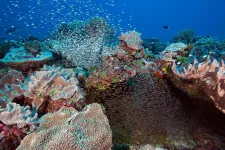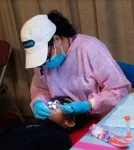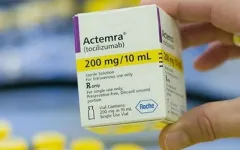(Press-News.org) Early exposure to tough conditions--particularly warmer waters and nightly swings of low oxygen--could leave lasting scars on oysters' ability to grow meaty tissue. A team of biologists at the Smithsonian Environmental Research Center (SERC) reported the discovery in a new study, published online Feb. 26 in the journal Ecological Applications.
Eastern oysters in Chesapeake Bay live mostly in shallow tributaries. It's a rough environment for shellfish that can't move. During hotter months, oxygen levels can swing drastically, from perfectly healthy levels in the day to near zero at night. To save energy, some oysters react by focusing more on shell growth than tissue growth. That could pose a problem for anyone involved in the seafood industry.
"What we all of course want to eat at the raw bar is the oyster tissue," said Sarah Donelan, a SERC postdoctoral fellow and lead author of the new report. "Customers and restaurants might be less pleased if there's less tissue in what looks to be a large oyster."
Total oyster growth suffered most when oysters experienced low oxygen alone. But early exposure left marks that were far easier to miss. There, researchers discovered a sharp drop in how fast oysters grow tissue versus shell. Oysters invested more in growing their shells--and less in the succulent, slurpable tissue inside--when exposed to the double punch of low oxygen and warmer waters both early and later in life.
Scars That Lie Dormant
For this study, Donelan teamed up with SERC senior scientists Matt Ogburn and Denise Breitburg. Ogburn studies conservation of oysters and other fishery species in Chesapeake Bay. Breitburg specializes in how fish and shellfish cope with the many environmental dangers that can coexist in the Chesapeake.
"Low oxygen and warming waters are a real double whammy for marine organisms," Breitburg said. "Warmer water holds less oxygen and causes oxygen to decline faster. At the same time, cold-blooded animals like oysters and finfish require more oxygen at warmer temperatures."
Donelan, an evolutionary biologist, wanted to find out if exposure to threats when very young could shape oysters later in life. Nightly swings of low oxygen put a special brand of pressure on the shellfish.
"If it's always bad, they can evolve over time to cope with those poor conditions," Donelan said. "But especially for [immobile] organisms like oysters, these fluctuations can be very stressful."
Donelan ran her experiment in a small lab SERC scientists affectionately call "The Room of DOOM" (the acronym stands for "Dissolved Oxygen Oyster Mortality"). It is a cramped, dark room filled with aquaria where biologists mimic conditions in shallow Chesapeake waters. Donelan took 3,600 young oysters, each about 3 months old, and exposed them to four possible scenarios. Some oysters experienced hotter water temps, some experienced nightly swings of low oxygen, some received both, and some got neither. After 18 days, Donelan gave the oysters a rest.
At first the oysters did not look any worse for wear. All oysters were roughly the same size regardless of whether they had been in hot water, oxygen-starved water or perfectly normal water. When Donelan estimated each oyster's shell and tissue size, she did not find any significant differences either.
But the effects of stress may simply have lain dormant. After a two-month break, Donelan put half the oysters back into experimental tanks. When faced with the same rough conditions again, oysters that had suffered from both low oxygen and hotter waters in Phase One started showing signs of strain.
The oysters managed to grow to a respectable size. But Donelan noticed something odd: Compared to more pampered oysters, oysters that suffered both stressors twice grew their shells more than their tissue. Their tissue-versus-shell growth ratio was merely half that of oysters that escaped the early double exposure.
It was a troubling find, because for oysters and oyster farmers alike, the meaty tissue is what really matters.
Ensuring A Safe Start
This raised a question for the biologists: Why would early exposure not toughen up the oysters instead? Donelan has spent her career watching animals adapt, and she's seen it work both ways. In this case, she suspects the combination of warming and low oxygen leaves a scar that does not easily heal.
"I think that there's likely a physiological change that's irreversible," Donelan said.
Perhaps a critical gene turned off--or turned on. Perhaps something in the oyster's microbiome shifted, making them less efficient at processing oxygen. Whatever went on behind the scenes, it pushed the oysters to grow their shells more than the tissue they need to survive and spawn more oysters.
Fortunately, oyster farmers have some options for protecting their stock. This could involve tracking oxygen levels in the water, to see which areas are vulnerable to low-oxygen swings. It could mean bubbling extra oxygen into oxygen-starved zones. For farmers with indoor systems, keeping young oysters in tanks and out of the field longer could offer more protection.
"Of course it's more of a time investment to have to move oysters around or look at dissolved oxygen profiles on your farm, but it could be worth it," Donelan said.
The key, she said, is to protect oysters while they are still young. Oysters that were not exposed to the warm water-low oxygen combo early in life fared much better when they faced the same combo later.
Meanwhile, oysters are not the only creatures that suffer these "carryover effects" from stress. They contain a telling message for conservationists: What other dangers could be headed off by protecting organisms while they are young?
INFORMATION:
The study, titled "Context-dependent carryover effects of hypoxia and warming in a coastal ecosystem engineer," is available at https://esajournals.onlinelibrary.wiley.com/doi/abs/10.1002/eap.2315. For images, a full copy of the report or to speak with the authors, contact Kristen Minogue at minoguek@si.edu or (314) 605-4315.
Three studies - one each in Science, Science Translational Medicine, and Science Immunology - reveal the promise of newly engineered bispecific antibodies, including by demonstrating their power against previously inaccessible tumor cell targets for the first time, in two cases. These bispecific antibodies, which simultaneously bind to tumor antigens and T cells, cleared cancer cells without damaging healthy cells in mouse tumor models and/or cell culture experiments, across the three studies. The results highlight the therapeutic potential of this antibody type, which - unlike engineered immune cell therapies like CAR T - does not have to ...
In the middle of the Indian Ocean lies some of the last coral reef wilderness on Earth. The Chagos Archipelago, a collection of atolls, including Earth's largest - the Great Chagos Bank- is home to reefs that have been largely undisturbed by humans for the last 50 years. Some estimates indicate the Chagos Archipelago may contain more than half of the healthy coral reefs remaining in the entire Indian Ocean. These reefs are protected both by their remote location, and in one of the world's largest no-take marine reserves--the British Indian Ocean Territory (BIOT) marine protected area.
In 2015, scientists at the Khaled ...
Youth enrollment in Medicaid managed care across all states increased from 65 percent in 2000 to 94 percent in 2017.
Across the country, receipt of preventive care for youth in Medicaid managed care increased from 49 percent in 2000 to 59 percent in 2017, falling short of the 80 percent annual goal set by the Centers for Medicare and Medicaid Services (CMS).
Receipt of preventive care for youth in Medicaid managed care showed a significant increase in 17 states, a significant drop in six states, and no change in 28 states. Tennessee had the largest increase in preventive care associated with Medicaid managed care, while North Carolina showed the largest decrease.
Nationally, the number of children under age 21 enrolled in Medicaid grew from ...
A school-based cavity prevention program involving nearly 7,000 elementary school students reduced cavities by more than 50 percent, according to a study led by researchers at NYU College of Dentistry. The findings are END ...
White blood cells or lymphocytes are the soldiers of our immune system that patrol the body via the lymphatic system. While their primary role is to protect the body by scavenging invaders, they can sometimes go rogue and become the enemy. Lymphoma, a type of blood cancer, results from the uncontrolled proliferation of lymphocytes. They are classified as Hodgkins and Non-Hodgkins lymphomas on the basis of the cell of origin and clinical characteristics. Of them, diffuse large B-cell lymphoma (DLBCL) is the most common Non-Hodgkins lymphoma and is highly aggressive and fast-growing.
A combination of rituximab plus cyclophosphamide, doxorubicin, vincristine, and prednisone (R-CHOP) is the standard treatment regimen for ...
In a new commentary for the journal Science, an associate vice president for research at The University of Texas at Arlington argues that emerging protein-based immunotherapies could lead to highly effective "off-the-shelf" cancer treatments for more patients.
Jon Weidanz, who also is a professor in the College of Nursing and Health Innovation at UTA, is the author of a perspective regarding the development of cancer immunotherapies.
His article, "Targeting cancer with bispecific antibodies," will appear in the March 5 edition of Science. It evaluates the findings of three studies by researchers at Johns Hopkins University and proposes that an emerging ...
In a study published online February 25, 2021 in The New England Journal of Medicine, a repurposed drug used to treat arthritis did not significantly improve the outcomes of patients with severe COVID-19 pneumonia.
Results of the Phase III clinical trial, conducted by an international team led by senior author Atul Malhotra, MD, research chief of pulmonary, critical care and sleep medicine at UC San Diego Health, found that tocilizumab did not significantly improve clinical status or mortality rate at 28 days for participants who received it compared to a placebo.
"Although our trial was negative based on primary outcomes, we did see some benefits, including an improvement in length of stay of eight days ...
In early 2020, daily life in Northern China slammed to a halt as the region entered a strict period of lockdown to slow the spread of COVID-19. Emissions from transportation and industry plummeted. Emissions of nitrogen oxides (NOx) from fossil fuels fell by 60 to 70 percent.
And yet, environmental researchers noticed that ground-level ozone pollution in Beijing and the Northern China Plain skyrocketed during this time period, despite the decrease of NOx, a component of ozone.
The region is no stranger to severe ozone pollution but until about five years ago, most ozone events occurred ...
CORVALLIS, Ore. - Oregon State University research has revealed a crucial mechanism behind one of humankind's most deadly physiological processes: the movement of malignant cells from one part of the body to another.
Published in the Proceedings of the National Academy of Sciences, the study led by OSU biophysicist Bo Sun shows the role that tissues' microscopic geometry plays in cancer metastasis, the internal spreading of the disease that's responsible for 95% of all cancer deaths.
To develop drugs that effectively combat metastasis, it's fundamentally important to understand what directs the metastatic process, Sun said.
"Our results show the level of tissue fiber alignment, particularly ...
A University of Melbourne led study has established how plants use their metabolism to tell time and know when to grow - a discovery that could help leverage growing crops in different environments, including different seasons, different latitudes or even in artificial environments and vertical gardens.
Published in the PNAS journal, Superoxide is promoted by sucrose and affects amplitude of circadian rhythms in the evening, details how plants use their metabolism to sense time at dusk and help conserve energy produced from sunlight during the day.
Lead ...






